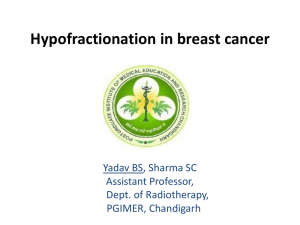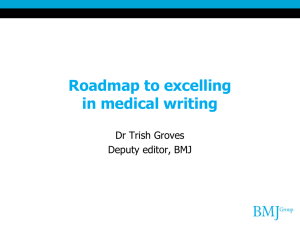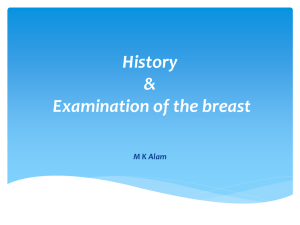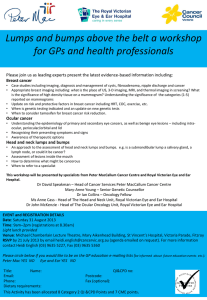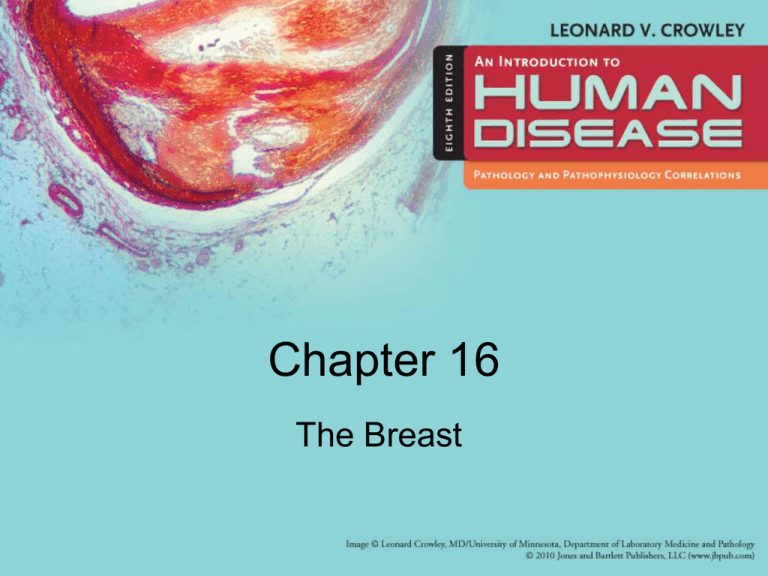
Chapter 16
The Breast
Learning Objectives
• Describe normal structure and physiology of breast
and common developmental abnormalities
• Explain applications and limitations of
mammography in the diagnosis and treatment of
breast disease
• Describe three common breast diseases that
present as lump in the breast
• Describe clinical manifestations of breast
carcinoma, methods of diagnosis and treatment
• Explain role of heredity in the pathogenesis of
breast carcinoma
Breast Structure (1 of 4)
• Breasts: modified sweat glands specialized to
secrete milk
• Main function is milk production
• Two main types of tissues
– Glandular tissues (lobules and ducts)
– Stromal (supporting) tissues
– Supporting tissue includes fatty and fibrous
connective tissue that give the breast its size, shape,
and support
• Two main types of breast changes
– Benign (non-cancerous)
– Malignant (cancerous)
Breast Structure (2 of 4)
• Composed of 20 lobes of glandular tissue
– Each lobe made up of a cluster of milk-producing glands
or lobules
– Lobules connected by branching ducts or small tubes and
converge to the nipple
– Fat and connective tissue, blood vessels, lymph vessels
• Suspensory ligaments: bands of fibrous tissue
extending from skin of breast to the connective
tissue covering chest wall muscles
Breast Structure (3 of 4)
• Abundant blood supply and lymphatic
drainage
– Lymph vessels carry lymph fluid instead of blood
– Most lymph vessels of breast lead to the axillary
nodes (supraclavicular and mediastinal nodes)
– If breast cancer cells reach axillary nodes and
continue to grow, nodes swell and cancer more
likely to spread to other organs
Breast Structure (4 of 4)
• Puberty: enlarge in response to estrogen and
progesterone
• Post-pubertal changes
– Proliferation of glandular and fibrous tissue
– Accumulation of adipose tissue
• Variations in breast size depend on amount of fat
and fibrous tissue rather than glandular tissue
• Extremely responsive to hormonal stimulation
– Menstrual cycle: cyclic hyperplasia followed by involution
– Pregnancy and lactation: hypertrophic glandular and
ductal tissues
– After menopause: sex hormone levels decline, breasts
gradually decrease in size
Tissue Changes Secondary to Hormone Levels
Normal, non-pregnant
Glandular hyperplasia, pregnant Postmenopausal atrophy
Breast Examination (1 of 3)
• Clinical examination
–
–
–
–
–
Inspection, palpation, examination of axillary tissues
FIRST: arms at the sides
NEXT: arms elevated and lowered
FINALLY, hands on hips
Begin palpation at periphery of breast in a clockwise
direction until tissues under the nipples are examined
• Mammogram to identify lesions not detected on
clinical examination
– Baseline: age 35–40
– Annually: age 40 thereafter
Breast Examination (2 of 3)
• Mammogram
– Most useful for postmenopausal women, whose breasts
contain more fat and less glandular tissue than breasts
of younger women
– Dense tumor in a postmenopausal breast contrasts
sharply with the less-dense fatty tissue
– Younger woman’s breast have more glandular and
fibrous tissue that are denser and provide less contrast
Breast Examination (3 of 3)
• Mammogram may identify lesions not detected on
clinical examination
–
–
–
–
Denser cysts and tumors: white on mammogram
Less dense fatty tissue: dark on mammogram
Cysts and benign tumors: well circumscribed
Malignant tumors
• Have irregular borders
• Frequently contain fine flecks of calcium
Mammogram
Cysts and tumors - white
Fatty tissue: appear dark
Fibrous and glandular tissue:
appear as white strands
Calcifications
Stippled calcification in tumor
Ductal carcinoma, with
necrosis and calcification
Abnormalities in Breast Development
(1 of 3)
• Embryologically, breasts developed from column
of cells (mammary ridges) located anteriorly from
axilla to upper thighs
• Most of the ridges disappear during prenatal
development except for those at the midthoracic
area, giving rise to breasts and nipples
Abnormalities in Breast Development
(2 of 3)
• Accessory breasts and nipples: most commonly
found in the armpits or on lower chest below and
medial to the normal breasts
• Unequal development: fully developed breasts are
usually similar in size but not identical, sometimes
one fails to develop as much as its counterpart
Abnormalities in Breast Development
(3 of 3)
• Breast hypertrophy: at puberty, one or both
breasts over-respond to hormonal
stimulation; true hypertrophy is from
overgrowth of fibrous tissue, not glands or fat
• Gynecomastia: ductal and fibrous tissue of
adolescent male breast proliferate affecting
one or more breast; from temporary
imbalance of female and male hormones
(increase in estrogen) in the male at puberty
Extra nipple below and medial to left
breast and nipple
Common sites of
accessory breasts
Benign Cystic Change in the Breast
• Very common benign condition; also called
fibrocystic disease
• Focal areas of proliferation of glandular and fibrous
tissue
• Irregular cyclic response to hormones during
menstrual cycle
• Ultrasound examination helpful in distinguishing a
cystic from a solid mass
• Treatment
– Aspiration of cyst
– Surgical excision if no aspiration
Benign breast cysts,
in cross-section,
previously filled with fluid
Ultrasound, breast cyst
Fibroadenoma
• Benign
• Well-circumscribed tumor of
fibrous and glandular tissue
• Common in young women
• Surgically excised
Breast Carcinoma (1 of 4)
• Risk factors
– Familial tendency (mother or sister with breast
cancer)
– Hormonal factors
– Birth of first child after age 30
– Early menarche
– Late menopause
– Occurs in both sexes, but rare in men, whose
breasts are not subject to stimulation by
ovarian hormones
– Occurs 1 in every 10 women
Breast Carcinoma (2 of 4)
• Hormones have been used for many years to treat
menopausal symptoms consisting of estrogen
alone or estrogen + progestin
– Progestin: synthetic compound with progesterone
activity
• Combined hormone therapy (estrogen-progestin)
increases density of breast tissue, complicating
the interpretation of mammograms
• Risk related to hormone treatment
– Long-term estrogen-progestin use significantly
increases risk of breast carcinoma (8%)
– Long-term use of estrogen without progestin slightly
increases risk breast carcinoma (1%)
Breast Carcinoma (3 of 4)
• Inheritance of mutant breast cancer susceptibility
genes
• Mutant BRCA1 gene
–
–
–
–
Increases breast and ovarian carcinoma risk
Breast cancer risk at 80%
Ovarian cancer risk is at 20–40%
Large gene with many different mutations
• Mutant BRCA2 gene
– Breast cancer risk at 80%
– Lower ovarian carcinoma risk at 10–20%
Breast Carcinoma (4 of 4)
Clinical Manifestations
• Lump in the breast
• Nipple or skin retraction
Skin edema (orange peel sign)
Tumor infiltrates breast and becomes fixed
to chest wall; metastasis
Classification of Breast Carcinoma
• 1. Site of origin
– Ductal carcinoma (90%)
– Lobular carcinomas (10%)
– Non-infiltrating or in situ cancer
• Confined initially within the duct or lobule
• Becomes invasive and extends toward adjacent breast tissue
• 2. Presence or absence of invasion
• 3. Degree of differentiation of tumor cells
– Well-differentiated: cells that resemble normal breast
tissue
– Poorly-differentiated: bizarre cells arranged haphazardly;
immature; very different from normal breast tissue
Evolution of Breast Carcinoma
• Early stages: too small to be detected by breast
exam
– Mammogram can identify carcinoma up to 2 years
before detection by breast exam
• Cancer continues to grow, initially in situ;
eventually becomes invasive
• Metastasizes to axillary lymph nodes and distant
sites
• Problems with late metastases
• Early diagnosis allows prompt treatment and
improves the cure rate
Breast Cancer
Breast Carcinoma Treatment:
Surgical Resection
• 1. Modified radical mastectomy
– Also called total mastectomy with axillary lymph node
dissection
– Resecting entire breast, axillary tissue with lymph nodes;
leaves pectoral muscles
– May be followed by breast reconstruction
• 2. Partial mastectomy: removing only part of breast
with the tumor
– Lumpectomy: removing tumor + small amount of adjacent
breast tissue
– Axillary lymph nodes removed in both lumpectomy and
partial mastectomy followed by radiation to eradicate any
remaining carcinoma in the breast
Breast Carcinoma Treatment:
Adjuvant Therapy
• To eradicate any tumor cells that may have spread
beyond the breast
– Anticancer drugs (adjuvant chemotherapy)
– Anti-estrogen drugs (adjuvant hormonal therapy)
• Whichever method of treatment is selected, part of
tumor obtained is surgically tested to:
– 1. Detect presence of estrogen and progesterone
receptors
– 2. Detect amplification of HER-2 gene that speeds
growth rate of tumor cells; HER-2 positive tumors have
less favorable prognosis
Determining Hormone Receptor
Status of Tumor
• 1. Prognosis
– Estrogen receptors (ER) and progesterone receptors
(PR) in breast carcinoma
– Hormone receptor positive tumors are better
differentiated with favorable prognosis
– Patients with ER positive tumors may receive adjuvant
hormonal therapy with antiestrogen drug
• 2. Guide for treatment: tumors with hormone
receptors respond to anti-estrogen adjuvant
therapy
Recurrent and Metastatic
Carcinoma (1 of 2)
• May appear many years after original tumor has
been resected
• Tumor no longer curable, treatment is to control
growth, relieve symptoms, and improve quality of life
• Methods of treatment depend on the following
factors:
– Hormone receptor status of tumor
– Age of patient
– Length that elapsed from initial treatment to appearance of
metastasis
– Pre- and postmenopausal, hormone-receptor positive
tumor: use anti-estrogen drugs
Recurrent and Metastatic
Carcinoma (2 of 2)
• Methods of treatment
• Hormone-receptor positive tumor
– Premenopausal: anti-estrogen drugs
– Postmenopausal: aromatase inhibitor drugs
• Hormone-receptor negative tumor
– Hormonal manipulation if unresponsive to tamoxifen or
aromatase inhibitor
• Radiation
– To control metastatic deposits in bone and soft tissues
Breast Sarcoma
•
•
•
•
•
Rare in comparison to breast carcinoma
Arises from fibrous tissue or blood vessels
Large bulky tumor
May metastasize widely
Treatment is by surgical resection of the involved
breast
Breast Sarcoma
© Courtesy of Leonard Crowley, M.D./University of Minnesota Medical School
A Lump in the Breast
• Diagnostic possibilities
– 1. Cystic disease
– 2. Fibroadenoma
– 3. Carcinoma
• Diagnostic approach
– Clinical evaluation
– Mammogram
– Biopsy
Discussion
• Which statement regarding breast cancer risk is
UNTRUE?
– A. Late menses and early menopause can increase
breast cancer risk
– B. Risk is higher in families with a history of breast
cancer
– C. Hormone use can increase the risk of breast
cancer
– D. The risk is higher for women who have never
borne children



